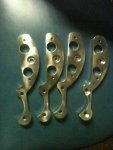It's finally here and I've got plenty of them ready to ship-- The 'MapDaddy' 4-bar Manifold Absolute Pressure (MAP) Sensor upgrade for the MegaSquirt, with one primary 4-bar MAP sensor for standard MAP Sensor duties, and a second for realtime barometric correction so that your fueling calculations will stay accurate in the event of an elevation change (mountain runs anyone?). The design was well thought through and is completely compatible with the MegaSquirt-1/2/3 with either the B&G standard or the Extra code variants, also fully supports all major PCB versions, PCB2.2, PCB3.0, and PCB3.57 units. Pretty much any hardware platform is good to go...

